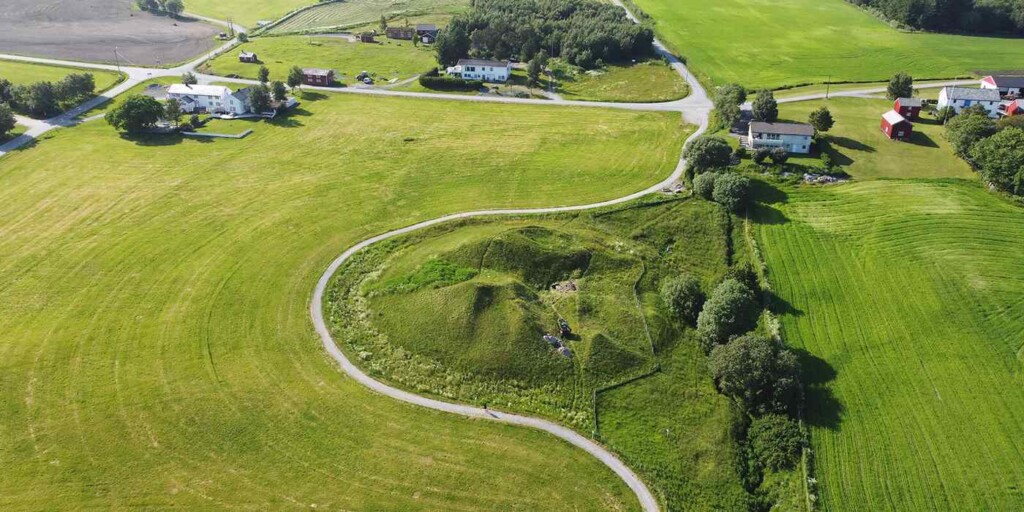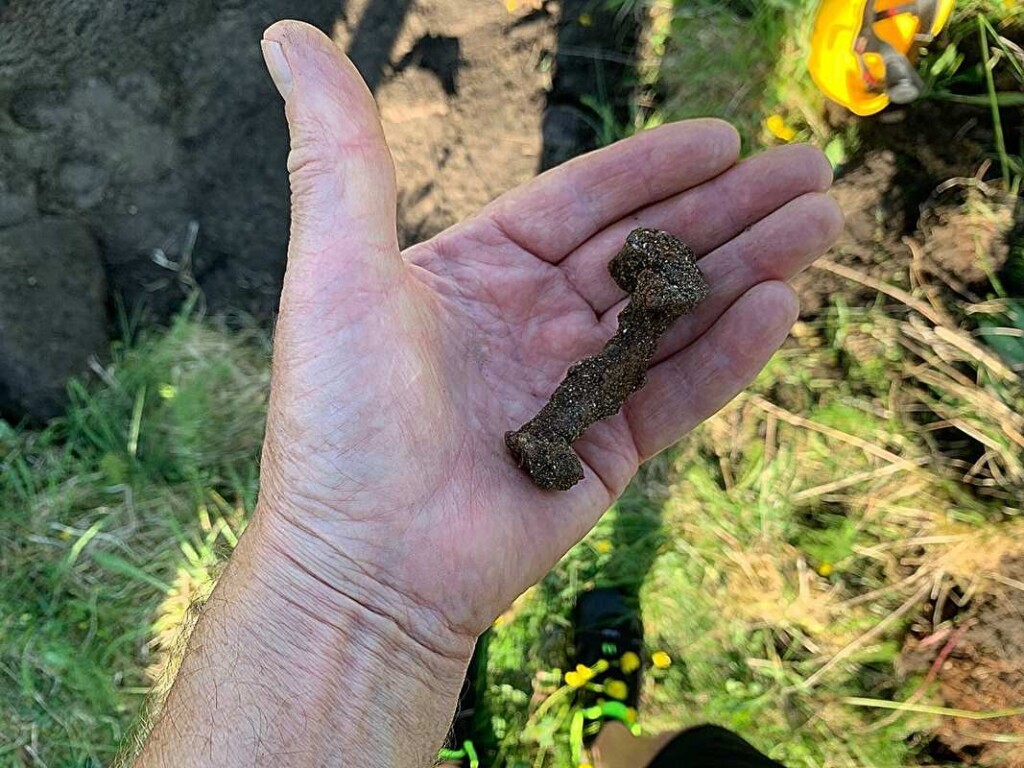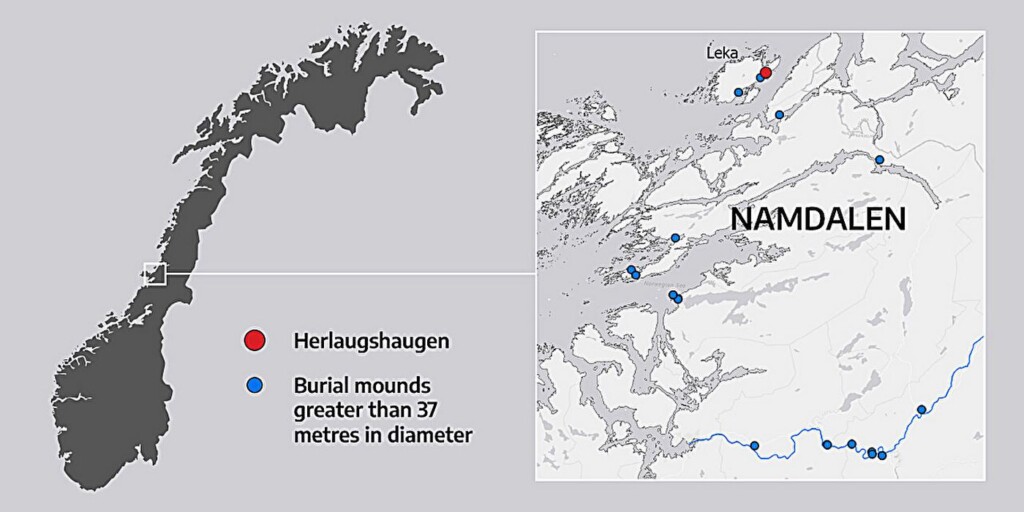Archeologists Confirm Oldest Viking Ship Burial in All Scandinavia–Could Rewrite the Viking Age
-Jan 1, 2024

The mound, called Herlaugshaugen, is mentioned in Snorre’s royal sagas as the final resting place of King Herlaug.
Hanne Bryn, NTNU University Museum.
County archaeologists have recently dated the remains of a Viking ship burial on a small island called Leka and found it to be the oldest one in all of Scandinavia.
In fact, it dates back so far, there’s a technical question about whether or not one can even call it a Viking ship burial, because funerary activities pre-date the Viking Age, when the term Viking began to be used for a Scandinavian mariner who spent some time trading and some time raiding.
The Herlaugshaugen burial mound in Leka is located in an archaeologically rich area called Namdalen. Here, there is a very unusually high concentration of burial mounds, but while most are unsurveyed and unexcavated, Herlaugshaugen had been excavated at three different times.
Records from the 18th and 19th centuries show that the mound contained construction materials like nails, a bronze cauldron, animal bones, and a seated skeleton with a sword. These have long since disappeared and interest in Herlaugshaugen for Norway’s recent ancestors concluded.
Now, a team of archaeologists and a professional metal detective went to survey the mound as part of a collaboration with the Norwegian Directorate for Cultural Heritage and Trøndelag County Authority.
They found iron nails and other evidence to suggest that the mound was the site of a ship burial, in which a man was interred around 700 CE, decades before the generally accepted start points of the Viking Age.
Furthermore, the ship was very large. Historians often credit the boat-building methods developed by the Scandinavians as one of several trends and forces that launched the Viking Age, but here, the appearance of a large sea-worthy vessel means that the technology and the will, capabilities, and commercial interests all existed to use it even before the 700 CE date. Ship nails of this size, and this age, tell us that people here could build large ships much earlier than previously believed. Credit: Geir Grønnesby.
Ship nails of this size, and this age, tell us that people here could build large ships much earlier than previously believed. Credit: Geir Grønnesby.
“This dating is really exciting because it pushes the whole tradition of ship burials quite far back in time,” Geir Grønnesby, an archaeologist at the NTNU University Museum, told Phys.org.
MORE VIKING STORIES: Viking Age Shipyard Uncovered at Birka is Like Nothing Ever Found Before
Viking raids may have been ongoing within Scandinavia at earlier periods, but the first outward acts of aggression by medieval Scandinavians are recorded as happening within the final quarter of the 8th century.
The other side of the Viking identity—that of the trader—may have already been fully developed at much earlier dates, such as the Merovingian Period, during which this burial was constructed.
“I think that the location along the shipping route plays a key role in understanding why Herlaugshaugen burial mound is located at Leka,” said archaeologist Lars Forseth from Trøndelag County Authority. “We know that whetstones have been traded from Trøndelag to the continent from the mid-700s onwards, and goods transport along the route is key to understanding the Viking Age and developments in ship design before the Viking Age.”
County archaeologists have recently dated the remains of a Viking ship burial on a small island called Leka and found it to be the oldest one in all of Scandinavia.
In fact, it dates back so far, there’s a technical question about whether or not one can even call it a Viking ship burial, because funerary activities pre-date the Viking Age, when the term Viking began to be used for a Scandinavian mariner who spent some time trading and some time raiding.
The Herlaugshaugen burial mound in Leka is located in an archaeologically rich area called Namdalen. Here, there is a very unusually high concentration of burial mounds, but while most are unsurveyed and unexcavated, Herlaugshaugen had been excavated at three different times.
Records from the 18th and 19th centuries show that the mound contained construction materials like nails, a bronze cauldron, animal bones, and a seated skeleton with a sword. These have long since disappeared and interest in Herlaugshaugen for Norway’s recent ancestors concluded.
Now, a team of archaeologists and a professional metal detective went to survey the mound as part of a collaboration with the Norwegian Directorate for Cultural Heritage and Trøndelag County Authority.
They found iron nails and other evidence to suggest that the mound was the site of a ship burial, in which a man was interred around 700 CE, decades before the generally accepted start points of the Viking Age.
Furthermore, the ship was very large. Historians often credit the boat-building methods developed by the Scandinavians as one of several trends and forces that launched the Viking Age, but here, the appearance of a large sea-worthy vessel means that the technology and the will, capabilities, and commercial interests all existed to use it even before the 700 CE date.
 Ship nails of this size, and this age, tell us that people here could build large ships much earlier than previously believed. Credit: Geir Grønnesby.
Ship nails of this size, and this age, tell us that people here could build large ships much earlier than previously believed. Credit: Geir Grønnesby.“This dating is really exciting because it pushes the whole tradition of ship burials quite far back in time,” Geir Grønnesby, an archaeologist at the NTNU University Museum, told Phys.org.
MORE VIKING STORIES: Viking Age Shipyard Uncovered at Birka is Like Nothing Ever Found Before
Viking raids may have been ongoing within Scandinavia at earlier periods, but the first outward acts of aggression by medieval Scandinavians are recorded as happening within the final quarter of the 8th century.
The other side of the Viking identity—that of the trader—may have already been fully developed at much earlier dates, such as the Merovingian Period, during which this burial was constructed.
“I think that the location along the shipping route plays a key role in understanding why Herlaugshaugen burial mound is located at Leka,” said archaeologist Lars Forseth from Trøndelag County Authority. “We know that whetstones have been traded from Trøndelag to the continent from the mid-700s onwards, and goods transport along the route is key to understanding the Viking Age and developments in ship design before the Viking Age.”

This map shows the approximate locations of the large burial mounds located in central Norway
. Map: Kolbjørn Skarpnes/NTNU. Credit: Map: Kolbjørn Skarpnes/NTNU
Ships would have been great signs of status, as they provided an economic link from the continent to these disparate Norwegian fjords and inlets. Anyone who owned one would have stood to make a lot of money, and the presence of the ship burial and the other mounds in Namdalen suggests to archaeologists like Forseth that the area of Namdalen may have played host to an elite merchant society.
KEEP READING ABOUT HISTORY: 4 Years After Discovery, the First Viking Ship Burial Found in Over 100 Years Reveals its Lost Secrets
Namdalen’s various valleys contain 10% of all the recorded burial mounds in Norway, but most haven’t been surveyed, so the idea has no legs as of yet.
Ships would have been great signs of status, as they provided an economic link from the continent to these disparate Norwegian fjords and inlets. Anyone who owned one would have stood to make a lot of money, and the presence of the ship burial and the other mounds in Namdalen suggests to archaeologists like Forseth that the area of Namdalen may have played host to an elite merchant society.
KEEP READING ABOUT HISTORY: 4 Years After Discovery, the First Viking Ship Burial Found in Over 100 Years Reveals its Lost Secrets
Namdalen’s various valleys contain 10% of all the recorded burial mounds in Norway, but most haven’t been surveyed, so the idea has no legs as of yet.
No comments:
Post a Comment